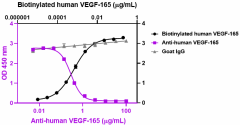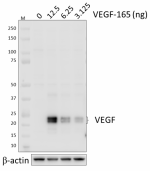- Clone
- Poly5225 (See other available formats)
- Regulatory Status
- RUO
- Other Names
- VEGFA165, MVCD1, VEGF, Vascular permeability factor (VPF)
- Isotype
- Goat Polyclonal IgG

-

Biotinylated recombinant human VEGF-165 (black squares) binds to immobilized recombinant human VEGFR1 (Cat. No. 555804). LEAF™ purified anti-human VEGF-165 antibody (clone Poly5225) (purple circles) inhibits the binding in a dose-dependent manner whereas the LEAF™ purified goat IgG isotype ctrl antibody (gray triangles) does not have the effect. This antibody blocks the binding of 10 ng/mL biotinylated recombinant human VEGF-165 to 1 µg/mL immobilized recombinant human VEGFR1. ND50 range: 0.15 - 0.75 µg/mL. -

Whole cell extracts (15 µg total protein) from Ramos cells mixed with the indicated amount of recombinant human VEGF-165 (Cat. No. 583704) were resolved by 4-12% Bis-Tris gel electrophoresis, transferred to a PVDF membrane, and probed with 1.0 µg/mL purified anti-human VEGF-165 antibody (Poly5225) overnight at 4°C. Proteins were visualized by chemiluminescence detection using HRP anti-goat IgG antibody at a 1:3000 dilution. Direct-Blot™ HRP anti-β-actin antibody (Cat. No. 664804) was used as a loading control at a 1:25000 dilution (lower). Lane M: Molecular weight marker.
| Cat # | Size | Price | Quantity Check Availability | ||
|---|---|---|---|---|---|
| 522505 | 100 µg | $452.00 | |||
VEGF (known also as VEGFA) was initially identified in conditioned medium from bovine pituitary follicular cells. VEGFA belongs to the VEGF family, which has the following members: VEGF-A, VEGF-B, VEGF-C (VEGF-2), VEGF-D, and PlGF (placental growth factor). In addition, viral VEGF homologs (collectively called VEGF-E) and snake venom VEGFs, such as T.f. (Trimeresurus flavoviridis) and svVEGF (called VEGF-F), have been described. VEGFA is alternatively spliced to generate variants with different numbers of amino acids, such as VEGFA121, VEGFA145, VEGFA165, and VEGFA189. VEGFA165 is predominant and responsible for VEGFA biological potency. While VEGF121 is freely diffusible and does not bind to neuropilins (NRPs) or heparan sulphate (HS), VEGF165 and VEGF189 bind to both, resulting in retention on the cell surface or in the extracellular matrix. NRP1 lacks a typical kinase domain and acts as a co-receptor, and in response to VEGF165, NRP1 couples with VEGF-Rs to signal in endothelial cells. In addition, it has been suggested that bone marrow cells that are recruited to Ewing’s tumors are differentiated into vascular smooth muscle cells, and VEGF165 is responsible for this differentiation. VEGFA is highly expressed in most of the solid tumors generated in breast, lung, renal, colorectal, and liver tissues. VEGFA has strong vascular permeability activity, and significantly contributes to the formation of ascites tumors. VEGFA can act as a direct proinflammatory mediator during the pathogenesis of rheumatoid arthritis (RA), and protect rheumatoid synoviocytes from apoptosis, which contributes to synovial hyperplasia. VEGFA is expressed in synovial macrophages and synovial fibroblasts in RA patients. Also, VEGFA is associated to age-related macular degeneration (AMD). AMD is due to neovascularization that originates from endothelial cells in the choroid that grow into neurosensory retina as choroidal neovascularization (CNV).
Product Details
- Verified Reactivity
- Human
- Antibody Type
- Polyclonal
- Host Species
- Goat
- Immunogen
- Recombinant human VEGF-165
- Formulation
- 0.2 µm filtered in phosphate-buffered solution, pH 7.2, containing no preservative.
- Preparation
- The LEAF™ (Low Endotoxin, Azide-Free) antibody was purified by affinity chromatography.
- Concentration
- The antibody is bottled at the concentration indicated on the vial. To obtain lot-specific concentration and expiration, please enter the lot number in our Certificate of Analysis online tool.
- Storage & Handling
- Upon receipt, store frozen at -20°C. Make small volume aliquots if needed and avoid repeated freeze-thaw cycles to prevent denaturing the antibody.
- Application
-
Block - Quality tested
WB - Verified - Recommended Usage
-
Each lot of this antibody is quality control tested by blocking the binding of 10 ng/mL biotinylated recombinant human VEGF-165 to 1 µg/mL immobilized recombinant human VEGFR1 (Cat. No. 555804) ND50 range: 0.15 - 0.75 µg/mL. It is recommended that the reagent be titrated for optimal performance for each application.
- Application Notes
-
This antibody has not been tested for ICC.
Specificity: While Poly5225 was generated specifically against VEGF-165 and is quality tested against VEGF-165, it may demonstrate some cross-reactivity to other isoforms of VEGF. - RRID
-
AB_2894616 (BioLegend Cat. No. 522505)
Antigen Details
- Structure
- Homodimer
- Distribution
-
Widely expressed
- Function
- VEGFA is a key player in vasculogenesis, the formation of blood vessels from progenitor cells, as well as angiogenesis. The expression of the VEGFA gene is upregulated via hypoxia, estrogen, and NF-κB pathways. In addition, VEGFA is upregulated by PDGF-BB, P1GF, TGFβ1, IGF1, FGFs, HGF, TNFα, and IL-1. VEGFA induces proliferation and cell migration in endothelial cells, and plays important roles during wound healing. Also, VEGFA regulates haematopoietic stem cell survival. VEGFA interacts with vascular endothelial cells and monocytes/macrophages, which express VEGFR1. This interaction induces proliferation of endothelial cells and stimulates migration of monocytes/macrophages. VEGFR2 is expressed in endothelial cells and VEGFR2-signaling is essential for the development of vascular systems in the embryo.
- Interaction
- Embryonic Stem Cells, Mesenchymal Stem Cells, Neural Stem Cells
- Ligand/Receptor
- VEGFA binds and activates two tyrosine kinase receptors, VEGFR1 (Flt-1), VEGFR2 (KDR/Flk-1)
- Antigen References
-
1. Conn G, et al. 1990. P Natl Acad Sci USA. 87:1323.
2. Gerber H, et al. 2002. Nature. 417:954.
3. Shibuya M, et al. 2006. J Biochem Mo. Biol. 39:469.
4. Reddy K, et al. 2008. Angiogenesis. 11:257.
5. Shibuya M. 2008. BMB Rep. 41:278.
6. Monaghan-Benson E, et al. 2010. Am J. Pathol. 177:2091.
7. Koch S and Claesson-Welsh L. 2012. Cold Spring Harb Perspect Med. 2:a006502. - Gene ID
- 7422 View all products for this Gene ID
- UniProt
- View information about VEGF-165 on UniProt.org
Other Formats
View All VEGF-165 Reagents Request Custom Conjugation| Description | Clone | Applications |
|---|---|---|
| Biotin anti-human VEGF | Poly5225 | ELISA Detection |
| LEAF™ Purified anti-human VEGF-165 | Poly5225 | Block,WB |
Compare Data Across All Formats
This data display is provided for general comparisons between formats.
Your actual data may vary due to variations in samples, target cells, instruments and their settings, staining conditions, and other factors.
If you need assistance with selecting the best format contact our expert technical support team.
-
Biotin anti-human VEGF

-
LEAF™ Purified anti-human VEGF-165

Biotinylated recombinant human VEGF-165 (black squares) bind... 
Whole cell extracts (15 µg total protein) from Ramos cells m...
